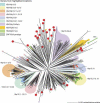A comprehensive catalog of human KRAB-associated zinc finger genes: insights into the evolutionary history of a large family of transcriptional repressors
- PMID: 16606702
- PMCID: PMC1457042
- DOI: 10.1101/gr.4842106
A comprehensive catalog of human KRAB-associated zinc finger genes: insights into the evolutionary history of a large family of transcriptional repressors
Abstract
Krüppel-type zinc finger (ZNF) motifs are prevalent components of transcription factor proteins in all eukaryotes. KRAB-ZNF proteins, in which a potent repressor domain is attached to a tandem array of DNA-binding zinc-finger motifs, are specific to tetrapod vertebrates and represent the largest class of ZNF proteins in mammals. To define the full repertoire of human KRAB-ZNF proteins, we searched the genome sequence for key motifs and then constructed and manually curated gene models incorporating those sequences. The resulting gene catalog contains 423 KRAB-ZNF protein-coding loci, yielding alternative transcripts that altogether predict at least 742 structurally distinct proteins. Active rounds of segmental duplication, involving single genes or larger regions and including both tandem and distributed duplication events, have driven the expansion of this mammalian gene family. Comparisons between the human genes and ZNF loci mined from the draft mouse, dog, and chimpanzee genomes not only identified 103 KRAB-ZNF genes that are conserved in mammals but also highlighted a substantial level of lineage-specific change; at least 136 KRAB-ZNF coding genes are primate specific, including many recent duplicates. KRAB-ZNF genes are widely expressed and clustered genes are typically not coregulated, indicating that paralogs have evolved to fill roles in many different biological processes. To facilitate further study, we have developed a Web-based public resource with access to gene models, sequences, and other data, including visualization tools to provide genomic context and interaction with other public data sets.
Figures


References
-
- Abrink M., Ortiz J.A., Mark C., Sanchez C., Looman C., Hellman L., Chambon P., Losson R., Ortiz J.A., Mark C., Sanchez C., Looman C., Hellman L., Chambon P., Losson R., Mark C., Sanchez C., Looman C., Hellman L., Chambon P., Losson R., Sanchez C., Looman C., Hellman L., Chambon P., Losson R., Looman C., Hellman L., Chambon P., Losson R., Hellman L., Chambon P., Losson R., Chambon P., Losson R., Losson R. Conserved interaction between distinct Kruppel-associated box domains and the transcriptional intermediary factor 1β. Proc. Natl. Acad. Sci. 2001;98:1422–1426. - PMC - PubMed
-
- Altschul S.F., Gish W., Miller W., Myers E.W., Lipman D.J., Gish W., Miller W., Myers E.W., Lipman D.J., Miller W., Myers E.W., Lipman D.J., Myers E.W., Lipman D.J., Lipman D.J. Basic local alignment search tool. J. Mol. Biol. 1990;215:403–410. - PubMed
-
- Ayyanathan K., Lechner M.S., Bell P., Maul G.G., Schultz D.C., Yamada Y., Tanaka K., Torigoe K., Rauscher III F.J., Lechner M.S., Bell P., Maul G.G., Schultz D.C., Yamada Y., Tanaka K., Torigoe K., Rauscher III F.J., Bell P., Maul G.G., Schultz D.C., Yamada Y., Tanaka K., Torigoe K., Rauscher III F.J., Maul G.G., Schultz D.C., Yamada Y., Tanaka K., Torigoe K., Rauscher III F.J., Schultz D.C., Yamada Y., Tanaka K., Torigoe K., Rauscher III F.J., Yamada Y., Tanaka K., Torigoe K., Rauscher III F.J., Tanaka K., Torigoe K., Rauscher III F.J., Torigoe K., Rauscher III F.J., Rauscher III F.J. Regulated recruitment of HP1 to a euchromatic gene induces mitotically heritable, epigenetic gene silencing: A mammalian cell culture model of gene variegation. Genes & Dev. 2003;17:1855–1869. - PMC - PubMed
-
- Bailey J.A., Yavor A.M., Massa H.F., Trask B.J., Eichler E.E., Yavor A.M., Massa H.F., Trask B.J., Eichler E.E., Massa H.F., Trask B.J., Eichler E.E., Trask B.J., Eichler E.E., Eichler E.E. Segmental duplications: Organization and impact within the current human genome project assembly. Genome Res. 2001;11:1005–1017. - PMC - PubMed
-
- Bellefroid E.J., Poncelet D.A., Lecocq P.J., Revelant O., Martial J.A., Poncelet D.A., Lecocq P.J., Revelant O., Martial J.A., Lecocq P.J., Revelant O., Martial J.A., Revelant O., Martial J.A., Martial J.A. The evolutionarily conserved Kruppel-associated box domain defines a subfamily of eukaryotic multifingered proteins. Proc. Natl. Acad. Sci. 1991;88:3608–3612. - PMC - PubMed
Publication types
MeSH terms
Substances
Grants and funding
LinkOut - more resources
Full Text Sources
Other Literature Sources
Molecular Biology Databases
